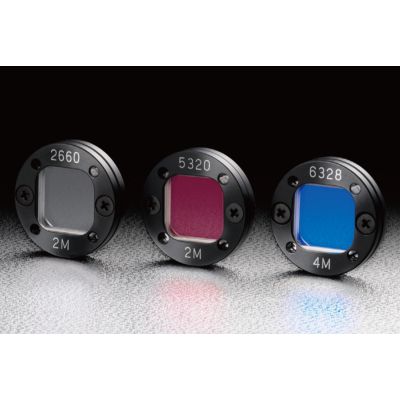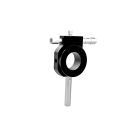Quartz Waveplate 30mm Diameter Wavelength 410nm λ/4
WPQ-4100-4M
Quartz waveplates are zero-order retardation plates (phase plates) which are assembled from pairs of optically contacted crystalline quartz plates and are mounted on aluminum frames. Unlike multiple-order (higher-order) waveplates that are made from a single quartz plate, the net retardations of zero-order waveplates are only slightly affected by temperature change.
◦These products utilize birefringence of quartz and give phase difference of λ/4 (π/2, 90°) or λ/2 (π, 180°) to the input beams. λ/4 retarders convert linearly polarization to circularly and circularly polarization to linearly. λ/2 retarders convert the direction of polarization in 90 degrees.
◦Usually linearly polarized beams are input to the waveplates in a leaning of 45 degrees against its optic axis.
◦Usually linearly polarized beams are input to the waveplates in a leaning of 45 degrees against its optic axis.
| Name | Quartz Waveplate 30mm Diameter Wavelength 410nm λ/4 |
|---|---|
| Weight | 0.0080kgs |
| Standard Coatings Available | No |
| Guide |
|
| Remark | - |
| Attention |
|
| Image Label | Quartz Waveplate 30mm Diameter Wavelength 410nm λ/4 |
| Material | Crystalline quartz |
| Material of frame | Aluminum (Finishing ; Black Anodized) |
| Clear aperture | 17×17mm |
| Surface flatness | λ/10 |
| Angular deviation of beam | <5″ |
| Coating | Antireflection Coating on both side |
| retardation tolerance |
<λ/50 (λ<400nm) λ/100〜λ/200 (400nm<λ<700nm) λ/200〜λ/500 (700nm<λ) |
| Transmittance | >98.5% |
| Laser Damage Threshold | 1J/cm2 (Laser pulse width ; 10ns , Repetition frequency ; 20Hz) |
| type | λ/4 |
| Wavelength range | 410nm |
| Theoretical retardation | 102.5nm |
In stock
SKU
WPQ-4100-4M
£544.90
Quartz waveplates are zero-order retardation plates (phase plates) which are assembled from pairs of optically contacted crystalline quartz plates and are mounted on aluminum frames. Unlike multiple-order (higher-order) waveplates that are made from a single quartz plate, the net retardations of zero-order waveplates are only slightly affected by temperature change.




